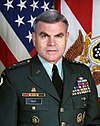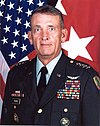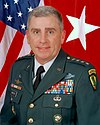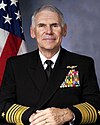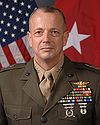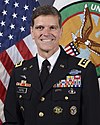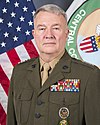United States Central Command
| United States Central Command (CENTCOM) | |
|---|---|
 Emblem of the United States Central Command | |
| Founded | January 1, 1983 (41 years, 6 months ago) |
| Country | |
| Type | Unified combatant command |
| Role | Geographic combatant command |
| Part of | United States Department of Defense |
| Headquarters | MacDill Air Force Base Florida,U.S. |
| Motto(s) | Persistent Excellence[1] |
| Engagements | Persian Gulf War Iraq War War in Afghanistan Operation Inherent Resolve |
| Website | centcom.mil |
| Commanders | |
| Commander | GeneralMichael E. Kurilla,USA[2] |
| Deputy Commander | Vice AdmiralCharles B. Cooper II,USN[3] |
| Senior Enlisted Leader | Fleet Master ChiefDerrick A. Walters,USN[4] |
| Insignia | |
| Shoulder Sleeve Insignia |  |
| NATO Map Symbol[5][6] |  |
| Unit Flag |  |
| United States Armed Forces |
|---|
 |
| Executive departments |
| Staff |
| Military departments |
| Military services |
| Command structure |
TheUnited States Central Command(USCENTCOMorCENTCOM) is one of the elevenunified combatant commandsof theU.S. Department of Defense.It was established in 1983, taking over the previous responsibilities of theRapid Deployment Joint Task Force(RDJTF).
ItsArea of Responsibility(AOR) includes theMiddle East(includingEgyptinAfrica),Central Asiaand parts ofSouth Asia.The command has been the main American presence in many military operations, including thePersian Gulf War's Operation Desert Storm in 1991, theWar in Afghanistan,as well as theIraq Warfrom 2003 to 2011. As of 2015[update],CENTCOM forces were deployed primarily in Afghanistan under the auspices ofOperation Freedom's Sentinel,which was itself part of NATO's Resolute Support Mission (from 2015 to 2021), and in Iraq and Syria as part ofOperation Inherent Resolvesince 2014 in supporting and advise-and-assist roles.
As of 1 April 2022[update],CENTCOM's commander isGeneralMichael E. Kurilla,U.S. Army.[7][8]Two of the last threeUnited States Secretaries of Defense-- incumbentLloyd AustinandJames Mattis,both of whom required congressional waivers to be confirmed -- were recent CENTCOM commanders.[9]
Of all seven American regional unified combatant commands, CENTCOM is among four that are headquartered outside their area of operations (the other three beingUSAFRICOM,USSOUTHCOM,andUSSPACECOM). CENTCOM's main headquarters is located atMacDill Air Force Base,inTampa, Florida.A forward headquarters was established in 2002 atCamp As SayliyahinDoha, Qatar,which in 2009 transitioned to a forward headquarters atAl Udeid Air BaseinQatar.
In January 2021,Israelbecame the 21st country of the AOR, added to another 20 nations includingAfghanistan,Bahrain,Egypt,Iran,Iraq,Jordan,Kazakhstan,Kuwait,Kyrgyzstan,Lebanon,Oman,Pakistan,Qatar,Saudi Arabia,Syria,Tajikistan,Turkmenistan,theUnited Arab Emirates,UzbekistanandYemen.[10]
History[edit]
The command was established on 1 January 1983.[11]As its name implies, CENTCOM covers the "central" area of the globe located between the African, European and Indo-Pacific Commands. When thehostage crisis in Iranand theSoviet invasion of Afghanistanunderlined the need to strengthen U.S. interests in the region, PresidentJimmy Carterestablished the Rapid Deployment Joint Task Force (RDJTF) in March 1980. Steps were taken to transform the RDJTF into a permanent unified command over a two-year period. The first step was to make the RDJTF independent ofU.S. Readiness Command,followed by the activation of CENTCOM in January 1983. Overcoming skeptical perceptions that the command was still an RDJTF in all but name, designed to support aCold Warstrategy, took time.
TheIran–Iraq Warclearly underlined the growing tensions in the region, and developments such as Iranian mining operations in thePersian Gulfled to CENTCOM's first combat operations. On 17 May 1987, theUSSStark(FFG-31),conducting operations in the Persian Gulf during the Iran-Iraq War,was struck by Exocet missiles fired by an Iraqi aircraft,resulting in 37 casualties. Soon afterward, as part of what became known as the "Tanker War",theFederal government of the United Statesreflagged and renamed 11Kuwaitioil tankers. InOperation Earnest Will,these tankers were escorted by USCENTCOM'sMiddle East Forcethrough the Persian Gulf to Kuwait and back through theStrait of Hormuz.[11]
By late 1988, the regional strategy still largely focused on the potential threat of a massiveSovietinvasion of Iran.Exercise Internal Lookhas been one of CENTCOM's primary planning events. It had frequently been used to train CENTCOM to be ready to defend theZagros Mountainsfrom a Soviet attack and was held annually.[12]
In autumn 1989, the main CENTCOM contingency plan, OPLAN 1002-88, assumed a Soviet attack through Iran to the Persian Gulf. The plan called for five-and-two-thirds US divisions to deploy, mostly light and heavy forces at something less than full strength (apportioned to it by the Joint Strategic Capability Plan [JSCAP]). The original plan called for these five-and-two-thirds divisions to march from the Persian Gulf to theZagros Mountainsand prevent theSoviet Ground Forces(army) from seizing theIranian oil fields.[13][14]
After 1990, GeneralNorman Schwarzkopfreoriented CENTCOM's planning to fend off a threat from Iraq, and Internal Look moved to a biennial schedule. There was a notable similarity between the 1990 Internal Look exercise scripts and the real-world movement of Iraqi forces which culminated in Iraq'sinvasion of Kuwaitduring the final days of the exercise.[12]U.S. PresidentGeorge Bushresponded quickly. A timely deployment of forces and the formation of a coalition deterred Iraq from invadingSaudi Arabia,and the command began to focus on the liberation of Kuwait. The buildup of forces continued, reinforced byUnited Nations Security Council Resolution 678,which called for Iraqi forces to leave Kuwait. On 17 January 1991, U.S. and coalition forces launchedOperation Desert Stormwith a massive air interdiction campaign, which prepared the theater for a coalition ground assault. The primary coalition objective, the liberation of Kuwait, was achieved on 27 February, and the next morning a ceasefire was declared, just one hundred hours after the commencement of the ground campaign.
The end of formal hostilities did not bring the end of difficulties with Iraq.Operation Provide Comfort,implemented to provide humanitarian assistance to the Kurds and enforce a"no-fly" zone in Iraq,north of the 36th parallel, began in April 1991. In August 1992,Operation Southern Watchbegan in response to Saddam's noncompliance withUnited Nations Security Council Resolution 688condemning his brutal repression of Iraqi civilians in southeastern Iraq. Under the command and control of Joint Task Force Southwest Asia, coalition forces in this operation enforced a no-fly zone south of the 32nd parallel. In January 1997,Operation Northern Watchreplaced Provide Comfort, with a focus on enforcing the northern no-fly zone. Throughout the decade, CENTCOM carried out a string of operations –Vigilant Warrior,Vigilant Sentinel,Desert Strike,Desert Thunder (I and II), andDesert Fox– to try to coerce Saddam into greater compliance with U.S. wishes.
The 1990s also brought significant challenges inSomaliaas well as from the growing threat of regional terrorism. To prevent widespread starvation as theSomali Civil Warcontinued, CENTCOM beganOperation Provide Reliefin 1992 to supply humanitarian assistance to Somalia and northeasternKenya.CENTCOM'sOperation Restore HopesupportedUnited Nations Security Council Resolution 794and a multinational Unified Task Force, which provided security until the U.N. createdUNOSOM IIin May 1993. In spite of some UNOSOM II success in the countryside, the situation inMogadishuworsened, and the significant casualties of theBattle of Mogadishuultimately led PresidentBill Clintonto order the withdrawal of all U.S. troops from Somalia.
Throughout the 1990s, following the Gulf War, terrorist attacks had a major impact on CENTCOM forces. Faced with attacks such as the1996 bombing of the Khobar Towers,which killed 19 American airmen, the command launched Operation Desert Focus, designed to relocate U.S. installations to more defensible locations (such asPrince Sultan Air Base), reduce the U.S. forward "footprint" by eliminating nonessential billets, and return dependents to the United States. In 1998 terroristsattacked the U.S. embassiesin Kenya andTanzania,killing 250 persons, including 12 Americans. The October 2000attack on the USSCole,resulting in the deaths of 17 U.S. sailors, was linked toOsama bin Laden'sAl Qaidaorganization.
From April to July 1999, CENTCOM conducted ExerciseDesert Crossing 1999,centered on the scenario ofSaddam Husseinbeing ousted as Iraq's dictator. It was held in the offices ofBooz Allen HamiltoninMcLean, Virginia.[15]The exercise concluded that unless measures were taken, "fragmentation and chaos" would ensue after Saddam Hussein's overthrow.
TheSeptember 11 terrorist attackson New York and Washington DC led PresidentGeorge W. Bushto declare a war against international terrorism. CENTCOM soon launchedOperation Enduring Freedomto expel the Taliban government in Afghanistan, which was harboring Al Qaida terrorists and hosting terrorist training camps.
Exercise Internal Lookhas been employed for explicit war planning on at least two occasions: Internal Look '90, which dealt with a threat from Iraq, and Internal Look '03, which was used to plan what became Operation Iraqi Freedom - the 2003United States invasion of Iraq,which began on 19 March 2003.
Following the defeat of both the Taliban regime in Afghanistan (9 November 2001) and Saddam Hussein's government in Iraq (8 April 2003), CENTCOM has continued to provide security to the new freely-elected governments in those countries, conducting counterinsurgency operations and assisting host nation security forces to provide for their own defense.
Beginning in October 2002, CENTCOM conducted operations in theHorn of Africato combat terrorism, establish a secure environment, and foster regional stability. These operations involved a series ofSpecial Operations Forcesraids, humanitarian assistance, consequence management, and a variety of civic action programs.
The command has also remained poised to provide disaster relief throughout the region; its most recent significant relief operations have been a response to the October 2005 earthquake inPakistan,and the large-scale evacuation of American citizens fromLebanonin 2006.

On 1 October 2008, the Department of Defense transferred responsibility forSudan,Eritrea,Ethiopia,Djibouti,Kenya, and Somalia to the newly established Africa Command.Egypt,home toExercise Bright Star,the Department of Defense's largest reoccurring military exercise, remained in the CENTCOMArea of Responsibility.On 15 January 2021, responsibility forIsraelwas transferred from Europe Command to CENTCOM.[16]
In January 2015, CENTCOM's Twitter feed was reported to have been hacked on 11 January byISISsympathizers.[17]This situation lasted for less than one hour; no classified information was posted and "none of the information posted came from CENTCOM's server or social media sites";[18]however, some of the slides came from the federally fundedLincoln Laboratoryat theMassachusetts Institute of Technology.[17]In August 2015,intelligence analystsworking for CENTCOM complained to the media, alleging that CENTCOM's senior leadership was altering or distorting intelligence reports on the Islamic State of Iraq and the Levant. In February 2017, the Inspector General of theUnited States Department of Defensecompleted its investigation and cleared the senior leadership of CENTCOM, concluding that "allegations of intelligence being intentionally altered, delayed or suppressed by top CENTCOM officials from mid-2014 to mid-2015 were largely unsubstantiated."[19]
In January 2018,Turkeyurged the United States to remove its troops fromSyriancity ofManbij,saying that otherwise they might come under attack from Turkish troops; however, former CENTCOM commanderJoseph Votelconfirmed an American commitment to keeping troops in Manbij.[20]In 2019, the Iranian government designated the United States Central Command a terrorist organization after theTrump administrationbranded Iran'sIslamic Revolutionary Guard Corpswith the same label.[21]
Structure[edit]
CENTCOM's main headquarters is located atMacDill Air Force Base,inTampa, Florida.CENTCOM headquarters staff directorates include personnel, intelligence, operations, logistics, plans & policy, information systems, training & exercises, and resources, and other functions. The intelligence section is known as Joint Intelligence Center, Central Command, or JICCENT, which serves as aJoint Intelligence Centerfor the co-ordination ofintelligence.Under the intelligence directorate, there are several divisions including theAfghanistan-Pakistan Center of Excellence.
Component Commands[edit]
CENTCOM directs five "service component commands" and onesubordinate unified command:
| Emblem | Command | Acronym | Commander | Established | Headquarters | Subordinate Commands |
|---|---|---|---|---|---|---|
 |
USARCENT | Lt GeneralPatrick Frank | 1918(as Third United States Army) | Shaw Air Force Base,South Carolina |
| |
  |
NAVCENT / FIFTHFLT | Vice AdmiralCharles Cooper II | 1983 | Naval Support Activity Bahrain,Bahrain |
*USCGCommand that augments NAVCENT in the CENTCOM AOR | |
  |
9 AF / USAFCENT | Lt GeneralAlexus Grynkewich | 21 August 1941 | Shaw Air Force Base,South Carolina |
*Assigned toAir Combat Commandas the 432nd Wing, but acts as 432nd Air Expeditionary Wing when operating in the CENTCOM AOR | |
 |
MARFORCENT | Maj GeneralPaul J. Rock Jr. | 2005 | Macdill Air Force Base,Florida | ||
 |
USSPACEFORCENT | ColonelChristopher Putnam | 2 December 2022 | Macdill Air Force Base,Florida |
Subordinate unified commands[edit]
| Emblem | Command | Acronym | Commander | Established | Headquarters | Subordinate Commands |
|---|---|---|---|---|---|---|
 |
Special Operations Command Central[27] | SOCCENT | Major GeneralKevin C. Leahy,USA | Macdill Air Force Base,Florida |
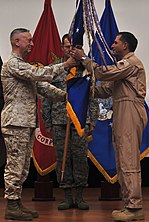
Two major subordinate multi-service commands reporting to Central Command were responsible for Afghanistan:Combined Joint Task Force 180and Combined Forces Command Afghanistan (CFC-A). CFC-A was disestablished in February 2007.[28]From that point onward, theInternational Security Assistance Force(ISAF) directed most U.S. forces in Afghanistan. A U.S. general (Dan K. McNeill) assumed command of ISAF that same month.[29]
Temporary task forces include the Central Command Forward – Jordan (CF-J), which was announced in April 2013.[30]CF-J's stated purpose was to work with the Jordanian armed forces to improve the latter's capabilities.[30]There was speculation, however, that another reason for its establishment was to serve as a base from which raids into Syria could be launched to seize Syrian WMD if necessary, and as a launch pad for looming American military action in Syria.[31][32][33]
On 1 October 2008Combined Joint Task Force - Horn of AfricaatCamp Lemonnierin Djibouti was transferred toUnited States Africa Command(USAFRICOM).[34]TheUnited States Forces – Iraqor USF-I, was a major subordinate multi-service command during theIraq War order of battleuntil it was disestablished in 2011.[citation needed]

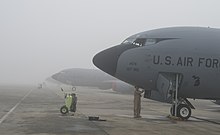
Elements of otherUnified Combatant Commands,especiallyUnited States Special Operations Command(USSOCOM), operate in the CENTCOM area. It appears that SOCCENT doesnotdirect the secretiveTask Force 88,the ad-hoc grouping ofJoint Special Operations Command'black' units such asDelta ForceandArmy Rangers,which is tasked to pursue the most sensitive high-value targets such as Al Qaeda and the Taliban leadership since 11 September 2001. Rather, TF 77, which started out asTask Force 11and has gone through a number of name/number changes, reports directly toJoint Special Operations Command,part of USSOCOM.[citation needed]
As of 2015[update],CENTCOM forces are deployed primarily in Iraq and Afghanistan in combat roles and have support roles at bases inKuwait,Bahrain,Qatar,theUnited Arab Emirates,Oman,andcentral Asia.CENTCOM forces have also been deployed in Jordan and Saudi Arabia.
War planning[edit]
The following war plan numbers have been made public:[35]
- OPLAN 1002-88, addressing Soviet-related armed conflict in the CENTCOM AOR[36]
- OPLAN 1002 (Defense of the Arabian Peninsula).[37]
- CENTCOM OPORDER 01-97, Force Protection
- SOCEUR SUPPLAN 1001-90, 9 May 1989
- CENTCOM CONPLAN 1010, July 2003
- CENTCOM CONPLAN 1015-98, possible support toOPLAN 5027for Korea, 15 March 1991
- CENTCOM 1017, 1999
- CONPLAN 1020
- OPLAN 1021, prior to 1990, referred to "the..Soviet threat."[38]OPLAN 1021-88 had a nuclear weapons annex, Annex C, that called for the deployment of some nuclear-capable forces. In September 1990, copying deployment lists from the Cold War planning in haste over to Desert Shield deployments after theIraqi invasion of Kuwaitappears to have inadvertently begun the deployment of aMGM-52 Lanceshort-range ballistic missile unit, 1st Battalion,12th Field Artillery Regiment."The unit's equipment was literally on railcars and ready to move to ports in Texas before the missilemen were ordered to stand down."[39]
- CONPLAN 1067, for possible Biological Warfare response
- CENTCOM CONPLAN 1100-95, 31 March 1992
Others listed by Arkin's supplements include CENTCOM CONPLAN 1211-07 "Foreign Humanitarian Assistance / Disaster Response Operations." It was issued in November 2007, and required using the Request for Forces method via then-U.S. Joint Forces Commandto supply any required forces.[40]
Geographic scope[edit]
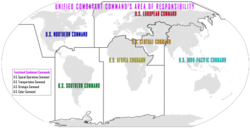
With the 1983 establishment of CENTCOM Egypt, Sudan, Kenya, Ethiopia, Somalia, and Djibouti came within thearea of responsibility(AOR). Thus CENTCOM directed the 'Natural Bond' exercises with Sudan, the 'Eastern Wind' exercises with Somalia, and the 'Jade Tiger' exercises with Oman, Somalia, and Sudan. Exercise Jade Tiger involved the31st Marine Expeditionary Unitwith Oman from 29 November 1982 to 8 December 1982.[41]
On 7 February 2007, plans were announced for the creation of aUnited States Africa Commandwhich transferred responsibility for U.S. military operations across Africa to the new USAFRICOM, except for Egypt. On 1October 2008, the Africa Command became operational andCombined Joint Task Force-Horn of Africa,the primary CENTCOM force on the continent, started reporting to AFRICOM atStuttgartinstead of CENTCOM in Tampa.
The Department of Defense uses a variable number of base locations depending on its level of operations. With ongoing warfare in Iraq and Afghanistan in 2003, theUnited States Air Forceused 35 bases, while in 2006 it used 14, including four in Iraq. TheUnited States Navymaintains one major base and one smaller installation, with extensive deployments afloat and ashore by U.S. Navy,U.S. Marine CorpsandU.S. Coast Guardships, aviation units and ground units.
List of commanders[edit]


| No. | Commander | Term | Service branch | |||
|---|---|---|---|---|---|---|
| Portrait | Name | Took office | Left office | Term length | ||
| 1 | General Robert Kingston (1928–2007) | 1 January 1983 | 27 November 1985 | 2 years, 330 days |  U.S. Army | |
| 2 | General George B. Crist (born 1931) | 27 November 1985 | 23 November 1988 | 2 years, 362 days |  U.S. Marine Corps | |
| 3 | General Norman Schwarzkopf Jr. (1934–2012) | 23 November 1988 | 9 August 1991 | 2 years, 259 days |  U.S. Army | |
| 4 | General Joseph P. Hoar (1934–2022) | 9 August 1991 | 5 August 1994 | 2 years, 361 days |  U.S. Marine Corps | |
| 5 | General J. H. Binford Peay III (born 1940) | 5 August 1994 | 13 August 1997 | 3 years, 8 days |  U.S. Army | |
| 6 | General Anthony Zinni (born 1943) | 13 August 1997 | 6 July 2000 | 2 years, 328 days |  U.S. Marine Corps | |
| 7 | General Tommy Franks (born 1945) | 6 July 2000 | 7 July 2003 | 3 years, 1 day |  U.S. Army | |
| 8 | General John Abizaid (born 1951) | 7 July 2003 | 16 March 2007 | 3 years, 252 days |  U.S. Army | |
| 9 | Admiral William J. Fallon (born 1944) | 16 March 2007 | 28 March 2008 | 1 year, 12 days |  U.S. Navy | |
| - | Lieutenant General Martin Dempsey (born 1952) Acting | 28 March 2008 | 31 October 2008 | 217 days |  U.S. Army | |
| 10 | General David Petraeus (born 1952) | 31 October 2008 | 30 June 2010 | 1 year, 242 days |  U.S. Army | |
| - | Lieutenant General John R. Allen (born 1953) Acting | 30 June 2010 | 11 August 2010 | 42 days |  U.S. Marine Corps | |
| 11 | General Jim Mattis (born 1950) | 11 August 2010 | 22 March 2013 | 2 years, 223 days |  U.S. Marine Corps | |
| 12 | General Lloyd Austin (born 1953) | 22 March 2013 | 30 March 2016 | 3 years, 8 days |  U.S. Army | |
| 13 | General Joseph Votel (born 1958) | 30 March 2016 | 28 March 2019 | 2 years, 363 days |  U.S. Army | |
| 14 | General Kenneth F. McKenzie Jr. (born 1957) | 28 March 2019 | 1 April 2022 | 3 years, 4 days |  U.S. Marine Corps | |
| 15 | General Michael Kurilla (born 1966) | 1 April 2022 | Incumbent | 2 years, 107 days |  U.S. Army | |
Secretary of Defense[edit]
Two of the former U.S. Central Command Commanders would later serve asUnited States Secretary of Defense:GeneralJames Mattisand GeneralLloyd Austin.Mattis served as the 26th U.S. Secretary of Defense. Austin became the 28th U.S. Secretary of Defense on January 22, 2021; he is the current incumbent.[42]
Unit decorations[edit]
The unit awards depicted below are for Headquarters, U.S. Central Command at MacDill AFB. Award for unit decorations do not apply to any subordinate organization such as the service component commands or any other activities unless the orders specifically address them.
| Award streamer | Award | Dates | Notes |
|---|---|---|---|
| Joint Meritorious Unit Award | 2 August 1990 – 21 April 1991 | Department of the Army General Order (DAGO) 1991-22 & 1992-34[43] | |
| Joint Meritorious Unit Award | 1 August 1992 – 4 May 1993 | DAGO 1994-12 & 1996-01 | |
| Joint Meritorious Unit Award | 8 October 1994 – 16 March 1995 | DAGO 2001–25 | |
| Joint Meritorious Unit Award | 1 September 1996 – 6 January 1997 | Joint Staff Permanent Order (JSPO) J-ISO-0012-97 | |
| Joint Meritorious Unit Award | 1 October 1997 – 15 July 1998 | JSPO J-1SO-0241-98 | |
| Joint Meritorious Unit Award | 16 July 1998 – 1 November 1999 | JSPO J-1SO-0330-99 / DAGO 2001–25 | |
| Joint Meritorious Unit Award | 2 November 1999 – 15 March 2001 | ||
| Joint Meritorious Unit Award | 11 September 2001 – 1 May 2003 | DAGO 2005–09 | |
| Joint Meritorious Unit Award | 2 May 2003 – 31 December 2005 | ||
| Joint Meritorious Unit Award | 1 January 2006 – 1 March 2008 | JSPO J-1SO-0061-08 | |
| Joint Meritorious Unit Award | 2 March 2008 – 1 July 2010 | ||
| Joint Meritorious Unit Award | 2 July 2010 – 31 July 2012 |
See also[edit]
References[edit]
- ^"COMMAND NARRATIVE".centcom.mil.
- ^"Commander, General Michael E. Kurilla".U.S. Central Command.Retrieved30 April2023.
- ^"Deputy Commander, Vice Admiral Brad Cooper".U.S. Central Command.Retrieved13 February2024.
- ^"Senior Enlisted Leader, Fleet Master Chief Derrick" Wally "Walters".U.S. Central Command.Retrieved30 April2023.
- ^FM 1-02 Operational Terms and Graphics(PDF).US Army. 21 September 2004. pp. 5–37.
- ^ADP 1-02 Terms and Military Symbols(PDF).US Army. 14 August 2018. pp. 4–8.
- ^Andrew Eversden(6 Jan 2022) Biden expected to name 18th Airborne Corps commander to CENTCOM
- ^"Webcast: CENTCOM Welcomes New Commander".DVIDS.1 April 2022.
- ^"Several Senate Armed Services members oppose Austin waiver".Roll Call.12 January 2021.Retrieved13 August2023.
- ^"AOR | U.S. Army Central".usarcent.army.mil.
- ^abCordesman 1998.
- ^abNorman Schwarzkopf (1993).It Doesn't Take a Hero.Bantam Books paperback edition. pp. 331–2, 335–6.ISBN0-553-56338-6.Harold Coyle's novelSword Pointgives an impression of what such planning envisaged and is by a U.S. Army officer who would have had some idea of the general planning approach.
- ^Swain 1997,p. 6.
- ^See alsohttps://apps.dtic.mil/sti/citations/AD1145131
- ^Gordon & Trainor 2012,pp. 6–7.
- ^Vandiver, John (15 January 2021)."CENTCOM mission expands to include Israel".Stars and Stripes.Retrieved26 January2021.
- ^ab"U.S. Central Command Twitter feed appears hacked by Islamic State sympathizers".Reuters.12 January 2015.Retrieved12 January2015.
- ^CHRIS GOOD, JOSHUA COHAN and LEE FERRAN (12 January 2015)."Home> International 'Cybervandalism': ISIS Supporters Hijack US Military Social Media Accounts".ABC.ABC news Internet Venture.Retrieved12 January2015.
- ^Cohen, Zachary (1 February 2017)."Report: Centcom leaders didn't cook ISIS intelligence".CNN.Retrieved10 April2018.
- ^McKirdy, Euan (29 January 2018)."US general: US troops won't withdraw from Syrian city of Manbij".CNN.
- ^Eqbali, Aresu; Rasmussen, Sune Engel (8 April 2019)."Iran Labels U.S. Central Command a Terrorist Organization".The Wall Street Journal.Retrieved7 January2020.
- ^"USARCENT Units".
- ^"U.S. NAVCENT Home Page".
- ^"AFCENT Home Page".
- ^"Marine Corps Forces Central Command".marcent.marines.mil.
- ^Hadley, Greg (2 November 2022)."Space Force to Establish Components for INDOPACOM, CENTCOM, Korea by End of 2022".
- ^"USCENTCOM > About Us > Component Commands".
- ^Goldman, Jan, ed. (7 October 2014).The War on Terror Encyclopedia: From the Rise of Al-Qaeda to 9/11 and Beyond.Abc-Clio. pp. 100–101.ISBN9781610695114– viaGoogle Books.
- ^Auerswald & Saideman 2014,pp. 96 onwards.
- ^abParrish, Karen (15 August 2013)."Dempsey Visits U.S. Troops Serving in Jordan".American Forces Press Service.Retrieved5 June2015.
- ^Nasser, Nicola (12 September 2013)."Amman's shaky claims to neutrality".Al-Ahram.Retrieved5 June2015.
- ^Shanker, Thom (15 August 2013)."With Eyes on Syria, U.S. Turns Warehouse Into Support Hub for Jordan".The New York Times.Retrieved5 June2015.
- ^McMorris-Santoro, Evan (31 August 2013)."Obama: I Have Decided To Bomb Syria, But I Want Congress To Weigh In First".buzzfeed.Retrieved5 June2015.
- ^"Africans Fear Hidden U.S. Agenda in New Approach to Africom".Associated Press. 30 September 2008.Retrieved30 September2008.
- ^Arkin 2005,p. 46.
- ^Diane T. Putney (2004).Airpower Advantage: Planning the Gulf War Air Campaign 1989–1991(PDF).pp. 10–11.
- ^https://williamaarkin.files.wordpress /2012/02/arkins-contingency-plans-of-the-us-government.pdfandArkin, William (1 January 2005)."National Security Contingency Plans of the U.S. Government"(PDF).
{{cite web}}:CS1 maint: date and year (link) - ^Swain 1997,p. 4.
- ^William Arkin,"Week Nine: SPECAT Nike Air,"Stars and Stripes (newspaper),September 25, 2000.
- ^Preston, Thomas J. (3 May 2010)."The Smarter Way to Plan for Deployment of Forces for Humanitarian Operations"(PDF).
- ^Arkin 2005,p. 404.
- ^Rej, Abhijnan."US Senate Confirms Lloyd Austin as Secretary of Defense".thediplomat.Retrieved26 January2021.
- ^"Department of the Army General Orders".United States Army Publishing Directorate.Archived fromthe originalon 27 April 2011.Retrieved30 April2011.(Army Knowledge Onlineaccount may be required.)
- Arkin, William (25 January 2005).Code Names: Deciphering U.S. Military Plans, Programs and Operations in the 9/11 World(First ed.). Steerforth.ISBN1586420836.
- Auerswald, David P.; Saideman, Stephen M. (2014).NATO in Afghanistan: Fighting Together, Fighting Alone.Princeton University Press.ISBN978-1-4008-4867-6.
- Cordesman, Anthony (August 1998)."USCENTCOM Mission and History"(PDF).Center for Strategic and International Studies.Anthony Cordesman
- Gordon, Michael R.; Trainor, Bernard E. (2012).The Endgame: The Inside Story of the Struggle for Iraq, from George W. Bush to Barack Obama.New York: Pantheon Books.ISBN978-0-307-37722-7.
- Swain, Richard Moody (1997).Lucky War: Third Army in Desert Storm.U.S. Army Command and General Staff College Press.ISBN9780788178658– viaGoogle Books.
External links[edit]
- U.S. Central Command official website
- Multi-National Force – Iraq mnf-iraq(in English)
- Multi-National Force – Iraqshurakaal-iraq(in Arabic)
- Spiegel, Peter (5 January 2007)."Naming New Generals A Key Step In Shift On Iraq".Los Angeles Times.
- Foreign Policy,Pentagon Ups the Ante in Syria Fight
- 2-star on Iraq: 'Still a big fight going on here'– Combined Joint Forces Land Component Command – Iraq, 2014
- Joe Biden inches toward war with Iran, makes Israel full military partner- Israel being reallocated to Central Command's area of responsibility





